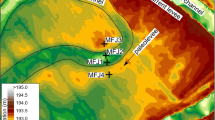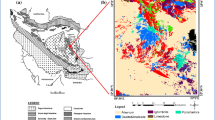Abstract
Descriptive analysis of multivariate spatial data is considerably aided by preliminary extraction of underlying factors or components, followed by analysis of the derived factor or componentscores. Much work has been done in this area, and a recent study proposed two contrasting types ofsuch factors which differ in their spatial features. One type comprises orthogonal factors that exhibit lack of spatial cross-correlation across the study region, while the other focusses on extracting maximum spatial structure but results in cross-correlated factors. Many applications would benefit from a combination of these types, so the present paper shows how they can be synthesized in order to produce factors that are approximately orthogonal and also maximise spatial structure. An alternating least squares process is described for doing the computations and its efficacy is evaluated by Monte Carlo simulation. The proposed method is illustrated on a study of trace elements across Vancouver Island, where it is shown that the extracted factors are orthogonal, have approximately zero spatial cross-correlations, and when their scores are plotted on maps of the study region then there is a definite indication of spatial structure. The main features of the two separate previous types of factors have thus been combined successfully into a single set.
Similar content being viewed by others
References
Bailey, T. C., and Krzanowski, W. J., 2000, Extensions to spatial factor methods with an illustration in geochemistry: Mathematical Geology, v. 32, p. 657–682.
Clark, I., Basinger, K. L., and Harper, W. V., 1989, MUCK—a novel approach to co-kriging, in Buxton, B. E., ed., Proceedings of the Conference on Geostatistical Sensitivity and Uncertainty Methods for Ground-Water Flow and Radionuclide Transport Modelling: Batelle Press, Columbus, p. 473–493.
Clarkson, D. B., 1988, Algorithm ASR74, a least squares version of algorithm AS211, the F-G diagonalisation algorithm: Appl. Stat., v. 37, p. 317–321.
Cleveland, W. S., Grosse, E., and Shyu, W. M., 1992, Local regresssion models, in Chambers J. M. and Hastie T. J., eds., Statistical Models in S: Wadsworth and Brooks, Pacific Grove, California p. 309–376.
Flury, B., 1988, Common Principal Components and Related Multivariate Models: John Wiley, New York.
Flury, B., and Constantine, G., 1985, Algorithm AS211, the F-G diagonalisation algorithm: Appl. Stat., v. 34, p. 177–183.
Goovaerts, P., 1993, Spatial orthogonality of the principal components computed from coregionalised variables: Math. Geol., v. 25, p. 281–302.
Goovaerts, P., 1997, Geostatistics for Natural Resources Evaluation: Oxford University Press, New York, p. 487.
Grunsky, E. C., and Agterberg, F. P., 1988, Spatial and multivariate analysis of geochemical data from metavolcanic rocks in the Ben Nevis area, Ontario: Math. Geol., v. 20, p. 825–861.
Grunsky, E. C., and Agterberg, F. P., 1991, SPFAC: a FORTRAN program for spatial factor analysis of multivariate data: Comput. Geosci., v. 17, p. 133–160.
Krzanowski, W. J., 2000, Principles of Multivariate Analysis: a User's Perspective (Revised Edition): Oxford University Press, Oxford, p. 586.
Myers, D. E., 1982, Matrix formulation of co-kriging: Math. Geol., v. 14, p. 249–257.
Nielsen, A. A., Conradsen, K., Pedersen, J. L., and Steenfelt, A., 1997, Spatial factor analysis of stream sediment geochemistry data from the South Greenland, in Pawlowsky-Glahn, V., ed., Proceedings of the Third Annual Conference of the International Association for Mathematical Geology, IAMG97: Barcelona, 22–27 September 1997 p. 955–960.
Nielsen, A. A., Conradsen, K., Pedersen, J. L., and Steenfelt, A., 2000, Maximum autocorrelation factorial kriging, in Kleingeld, W. J., and Krige, D. G., eds., Proceedings of the 6th International Geostatistics Congress, Geostats 2000: Cape Town, 10–14 April 2000 p. 538–547.
Percival, D. B., 1993, Three curious properties of the sample variance and autocovariance for stationary processes with unknown mean: Am. Stat., v. 47, p. 274–276.
Quenouille, M. H., 1957, The Analysis of Multiple Time Series: Griffin, London, p. 105.
Switzer, P., 1985, Min/max autocorrelation factors for multivariate spatial imagery: Computer Science and Statistics, Proceedings of the 16th symposium on the Interface, p. 13–16.
Switzer, P., and Green, A., 1984, Min/max autocorrelation factors for multivariate spatial imagery: Technical Report No. 6, Department of Statistics, Stanford University, Stanford, CA.
Ver Hoef, J. M., and Cressie, N., 1993, Multivariable spatial prediction: Math. Geol., v. 25, p. 219–240.
Wackernagel, H., 1998, Multivariate Geostatistics: Springer-Verlag, Berlin, p. 291.
Webster, R., 1978, Optimally partitioning soil transects: J. Soil Sci., v. 45, p. 205–218.
Author information
Authors and Affiliations
Corresponding author
Rights and permissions
About this article
Cite this article
Krzanowski, W.J., Bailey, T.C. Extraction of Spatial Features Using Factor Methods, Illustrated on Stream Sediment Data. Math Geol 39, 69–85 (2007). https://doi.org/10.1007/s11004-006-9067-3
Received:
Accepted:
Published:
Issue Date:
DOI: https://doi.org/10.1007/s11004-006-9067-3




